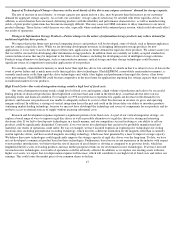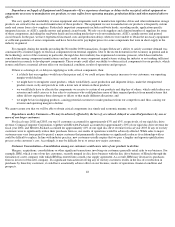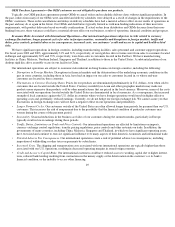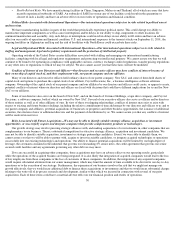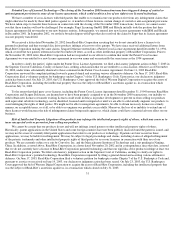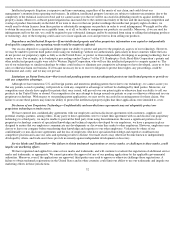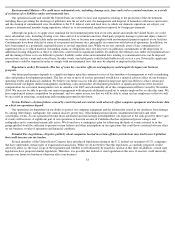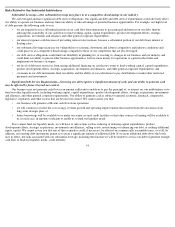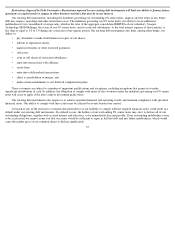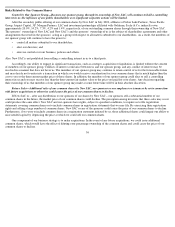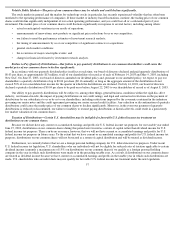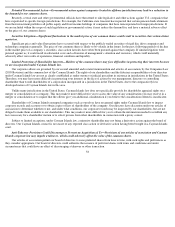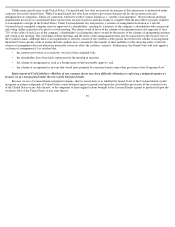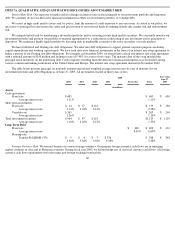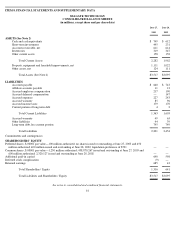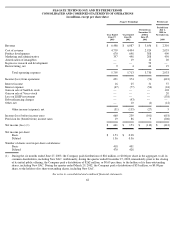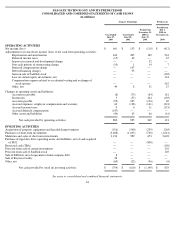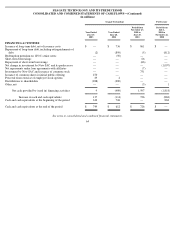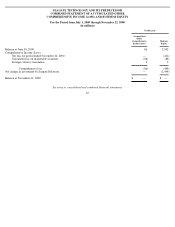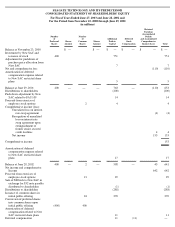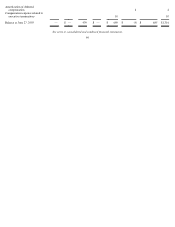Seagate 2002 Annual Report Download - page 62
Download and view the complete annual report
Please find page 62 of the 2002 Seagate annual report below. You can navigate through the pages in the report by either clicking on the pages listed below, or by using the keyword search tool below to find specific information within the annual report.
Volatile Public Markets—The price of our common shares may be volatile and could decline significantly.
The stock market in general, and the market for technology stocks in particular, has recently experienced volatility that has often been
unrelated to the operating performance of companies. If these market or industry-based fluctuations continue, the trading price of our common
shares could decline significantly independent of our actual operating performance, and you could lose all or a substantial part of your
investment. The market price of our common shares could fluctuate significantly in response to several factors, including among others:
•
actual or anticipated variations in our results of operations;
•
announcements of innovations, new products or significant price reductions by us or our competitors;
•
our failure to meet the performance estimates of investment research analysts;
•
the timing of announcements by us or our competitors of significant contracts or acquisitions;
•
general stock market conditions;
•
the occurrence of major catastrophic events; and
Failure to Pay Quarterly Distributions—Our failure to pay quarterly distributions to our common shareholders could cause the
market price of our common shares to decline significantly.
•
changes in financial estimates by investment research analysts.
In accordance with our quarterly dividend policy in effect at such time, our board of directors declared and paid quarterly distributions of
$0.03 per share, or approximately $13 million, to all of our shareholders of record as of each of February 14, 2003 and May 9, 2003, including
New SAC. On June 27, 2003, our board of directors amended our dividend policy and, pursuant to our amended policy, we expect to pay our
shareholders a quarterly distribution of up to $0.04 per share ($0.16 annually) so long as the aggregate amount of the distributions do not
exceed 50% of our consolidated net income for the quarter in which the distributions are declared. On July 14, 2003, our board of directors
declared a quarterly distribution of $0.04 per share to be paid on or before August 22, 2003 to our shareholders of record as of August 8, 2003.
Our ability to pay quarterly distributions will be subject to, among other things, general business conditions within the rigid disc drive
industry, our financial results, the impact of paying distributions on our credit ratings, and legal and contractual restrictions on the payment of
distributions by our subsidiaries to us or by us to our shareholders, including restrictions imposed by the covenants contained in the indenture
governing our senior notes and the credit agreement governing our senior secured credit facilities. Any reduction or discontinuation of quarterly
distributions could cause the market price of our common shares to decline significantly. Moreover, in the event our payment of quarterly
distributions is reduced or discontinued, our failure or inability to resume paying distributions at historical levels could result in a persistently
low market valuation of our common shares.
Taxation of Distributions—Certain U.S. shareholders may be ineligible for favorable U.S. federal income tax treatment on
distributions on our common shares.
Because we did not have any current or accumulated earnings and profits for U.S. federal income tax purposes for our taxable year ended
June 27, 2003, distributions on our common shares during this period were treated as a return of capital rather than dividend income for U.S.
federal income tax purposes. There can be no assurance, however, that we will not have current or accumulated earnings and profits for U.S.
federal income tax purposes in future years. To the extent that we have current or accumulated earnings and profits for U.S. federal income tax
purposes, distributions on our common shares will not be treated as a return of capital distribution and will be treated as dividend income.
Furthermore, we currently believe that we are a foreign personal holding company for U.S. federal income tax purposes. Under recent
U.S. federal income tax legislation, U.S. shareholders who are individuals will not be eligible for reduced rates of taxation applicable to certain
dividend income (currently a maximum rate of 15%) on distributions on our common shares if we qualify as a foreign personal holding
company in the year in which such distributions were made or in the preceding taxable year. As a result, if distributions on our common shares
are treated as dividend income because we have current or accumulated earnings and profits in the taxable year in which such distributions are
made, U.S. shareholders who are individuals may not qualify for favorable U.S. federal income tax treatment under the new legislation.
57


